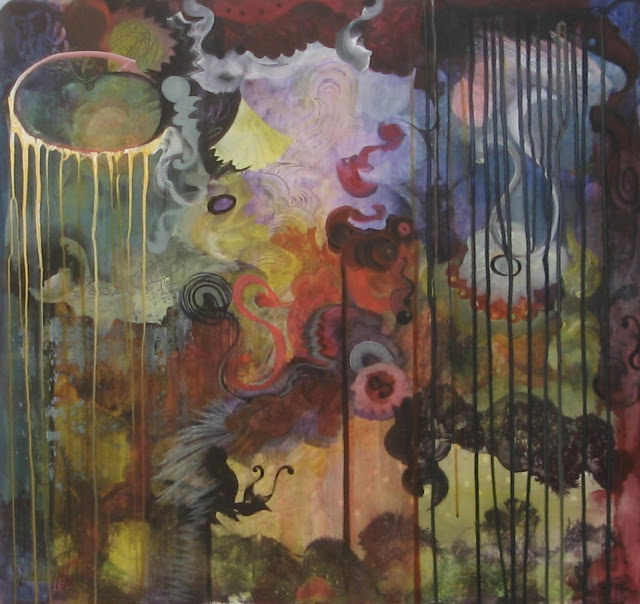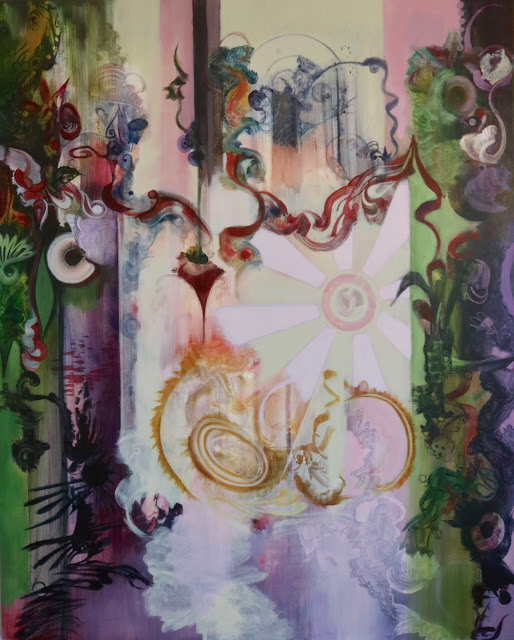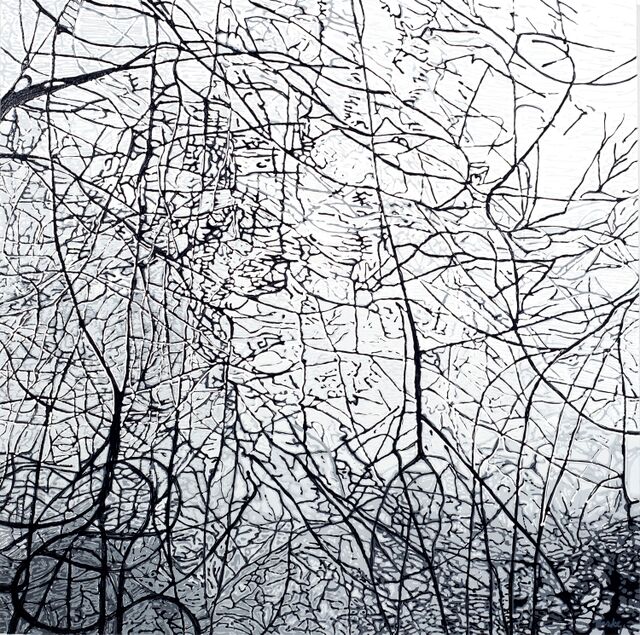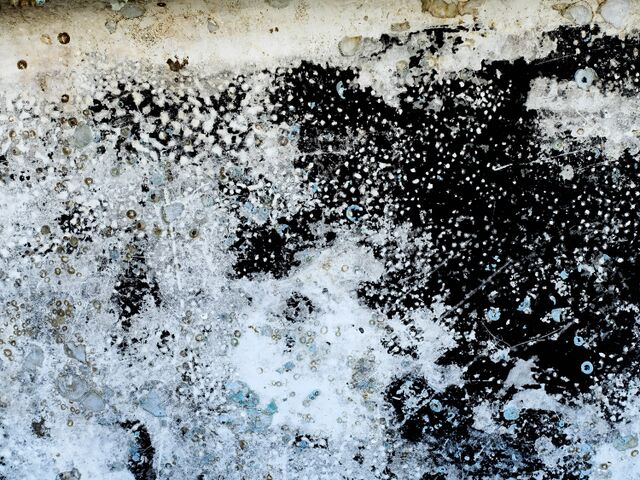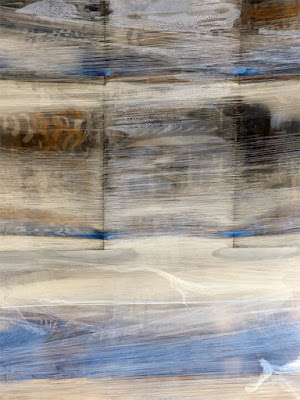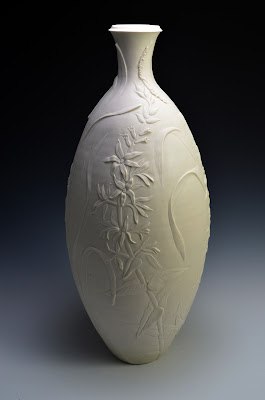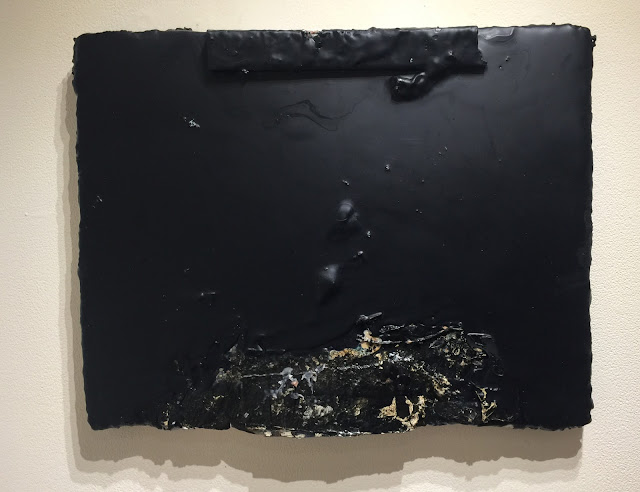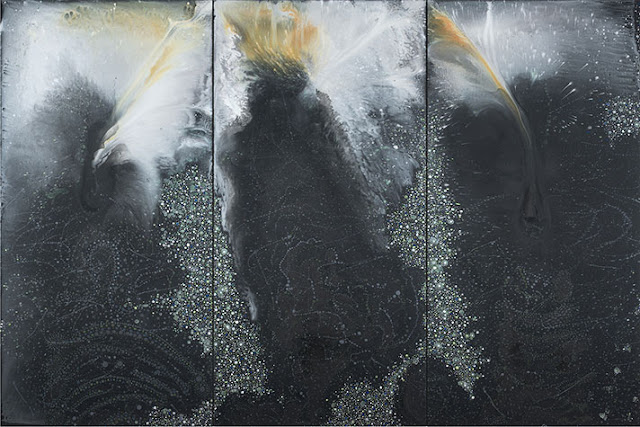Intertwined in some of the most satisfying art viewing experiences of the last few weeks there is a unity of orientation within seeming disparity as artists continue their practices in times that seem to push us all toward annihilation and so within, away from phenomenal surroundings and so inside to contact with the seemingly disparate traditions of our respective histories.
Everywhere art has long utilized spiritual aspirations, practices and religious myth as a raison d’être, recent lapses into irony and pomo cartoon aesthetic notwithstanding. The ascendance of base materiality and worship of profit seemed for a while to obliterate these functions, however as the the situation of our species becomes more dire, some artists find themselves on the front lines of this dichotomy and so in the work they are called to practice, reaches to the depths of their spiritual histories and orientation to give form to an integration that goes beyond particulars of personal history.
The stars of Michael David’s navigator, and the cosmic dots of Takenaga embody this integration in seemingly different ways.
This is concisely evidenced in Michael David’s statement of painting as a “secular spiritual practice” which “actualizes the state of being larger than ourselves.”
David is a long time veteran of the world of painting in New York, considered a prodigy he was the youngest artist to be awarded a Guggenheim in 1981. His work is considered one of the last links to the New York School.
“Where the abstract expressionist paintings of the forties and fifties seem like modern cave paintings, as their crude, unfocused, often meandering, turbulent painterliness suggests, and as such to reinstate prehistory, David seems to turn the cave into a temple, as his more considered, concentrated, indeed, dense, contemplative painterliness indicates, so that his paintings have the aura of post history.” https://en.wikipedia.org/wiki/Michael_David_(painter)
David’s recent exhibit this fall at John Davis, Navigators, Golems & Geishas contained works of presence, the sort of presence that signals connection to things larger than the work itself, which attribute both of these artists share.
In David’s case, as in Takenaga, this is partially achieved by literal reference to the infinite. David’s starscapes are of rougher stuff, both materially and in terms of content, referring as they do to a navigator not always sure of his cartography on this earth, in densely layered spaces of beeswax and other materials.
I inquired of a friend, who is an ordained minister well studied in the Abrahamic traditions about the meaning of golems. When he explained the protective function of this object in the Hebrew tradition it made sense as a metaphor for the protections that art, molded from inert matter as it is, bestows on its practitioners.
While checking the definition on wikipedia there is also mention of the word inscription, on the forehead (the seat of the visionary sixth chakra, or “third eye”) which may read emet for truth which signifies life, or, with its dissolution, met for death. The congruence of truth with life is useful, connecting as it does truth, which is eternal with life, which is an attribute of awakening from this dream.
Night Falls, 2016-17, Encaustic and Mixed Media on Wooden Panel, 22.5 x 28.5 inches
An interesting side note glimpsing the hope art engenders, is a young art teacher who is Palestinian and likes, NIGHT FALLS, a funereal and transcendent work, one silent in its smooth blackness and matt surface. This young person stakes his life on art’s ability to connect that which is seemingly opposed, as do many of us in seemingl;y “safer” environments ( I can only speak as a painter) in these times of seemingly irreconcilable differences.
The geisha is David’s Beatrice, represented by fragments of paper hanging (as worn, torn and discarded parts of kimonos?) This is where most of the chromatic elements of this show are seen, exhibiting a delicate and profound color sense.
The person accompanying me remarked that some of these pieces are reminiscent to him of bomb fragments. As a veteran of war he would know. Who can argue that we are, indeed, engulfed in a war on all levels, both material and spiritual now? As this last election proves, bombs are not always physical.
By The Lake, 2016, Encaustic and Mixed Media on Panel, 7.5 x 7.5 inches
When The Soul Leaves The Body 2, 2016-17, Mixed Media on Paper, 12 x 16 inches
David and many of his artists by no means a homogenous group, where he co-directs the David Schweitzer Gallery in Brooklyn, share a seasoned toughness germaine to the spiritual experience that is painting, in what may be the most materialist and fast paced environment in the country, if not the world.
For both of these artists, objects & mythologies are armatures for the story less non materiality and harmonies pervasive in the best abstract art.
The work of Barbara Takenaga delineates the realms of space in a more patterned, obsessive dot matrix which is organic rather than mechanical. Rather than punchinello or raster dots, these dots, the main armature of the paintings, are reminiscent of bhuddist prayer beads. They are applied and conceived by the artist as the growth patterns found in nature are and not mechanically with drafting processes.
Takenaga has stated the prime imperative of labor in her process. and so the meditative aspect of this process is central, every drop a fall or letting go. In the earlier work many of these spheres are hand painted. As the work progresses in time, more of these spheres are dropped onto the surface, the unknown known, in spaces of pouring infinity, like the mala beads monks use to pray with.
Takenaga’s history is that of growing up in the far reaching spaciousness of the midwest, which manifests in her themes of space hinting at infinity which is a prime attribute of spiritual practice. I heard the word “infinite” evoked several times during my brief visit to her interview with painter Tom Burkhardt at the installation at William’s college. Burkhardt referred to a “Locus just above center” in her work and she responded to this as “an artificial vantage point of reference into the infinite”.
Harmo, 2013, Acrylic on Linen, 42 x 36 inches
She then spoke of three themes of placement in her oeuvre, first a slightly elevated portrait orientation with light at its center, directing the gaze upward, secondly the horizontal of the vast plains, and finally the enormity of no horizon at all, a “ginormity overwhelming placement” which is made clear in the most recent and largest works shown here.
Black Tryptich, 2016, Acrylic on Linen, 72 x 108 inches
The artist has expanded on the earlier mandala meditations to inhabit places that are less structured and more evocative of space. Counter acting these fathomless spaces is a geode effect using free flowing jagged and curvilinear bands of color, reminiscent of similar elements of Tibetan Thanka painting panels.
Red Geode, 2015, Acrylic on Wood Panel, 24 x 20 inches
Takenaga teaches printmaking at Williams, and this process is leaking into the painting processes. White Grid on Silver was commenced with a rorschach doubling process which, along with the pouring process contrasts with the more tightly generated dots and the structures they make.
Just as grey makes bright colors sing more sharply, the loosely painted elements in these works give juice to the hard edged aspects of these compositions. The chromatic and tonal balances in these paintings add to their strength of impact.
It may be useful to compare works in terms of dichotomy & oppositions, and how balancing these may be prerequisite to accessing states beyond duality, which are “end of the road” spiritual quests. The work of these two artists, on the surface so very different, embodies, in differing methods, this quest. Takenaga’s, reminiscent of eastern traditions, emphasizes meditative labour and processes rooted in humility. David’s, oriented in the roots of the western tradition, places emphasis on action and exploration. What gives life to both of these bodies of work is a commonality of purpose, a moving toward and acknowledgement of higher spiritual states.
Barbara Takenaga, which runs through January 28 2018, at the Williams College Museum of Art is accompanied by a generously illustrated catalogue including a poem by Geoffrey Young.
